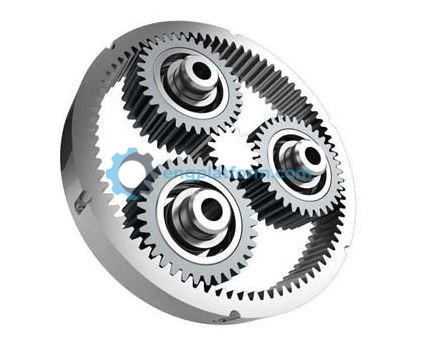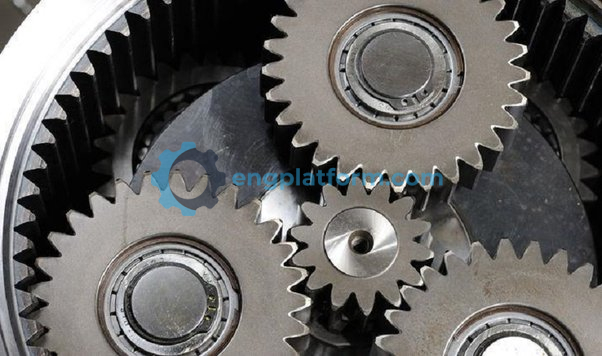What is a planetary gear?
A planetary gear set consists of two gears mounted so that one gear revolves around the center of the other. A carrier connects the centers of the two gears and rotates to carry a gear, called the planet gear or planet pinion, which revolves around the other gear, called the sun gear or sun wheel. The planet gear and sun gear mesh, so their pitch circles roll without slipping. A point on the pitch circle of the planet gear describes an epicycloid curve. In this simplified case, the sun gear is fixed, and the planet gear rolls around the sun gear.

A planetary gear train can be assembled so that the planet gear rolls inside a fixed outer gear ring, sometimes called an annular gear. In this case, a point on the planet gear’s pitch circle describes an hypocycloid curve.
A planetary gear system that simultaneously meshes with the sun gear and an outer ring gear is called a planetary gear set. In this case, the ring gear is usually fixed, and the sun gear is driven.
A planetary gear transmission is a gear system that consists of one or more outer, or system planet gears or pinions, revolving around a central star gear or sun wheel. Typically, the planet gears are mounted on a movable arm or carrier, which itself may rotate relative to the sun gear. The revolving gear system also incorporates an outer ring gear or annulus, with which the planet gears mesh. Planetary gears (or epicyclic gears) are typically classified as simple or compound planetary gears. Simple planetary gears have one sun, one ring, one carrier, and one planet set. Compound planetary gears involve one or more of the following three structures: meshed planets (at least two planets mesh with each other in each planet set), stepped planets (there is a shaft connection between two planets in each planet set), and multi-stage structures (the system contains two or more planet sets). Compared to simple planetary gears, compound planetary gears have advantages such as greater reduction ratios, higher torque-to-weight ratios, and more flexible configurations.
The axes of all gears are usually parallel, but for special cases such as pencil sharpeners and differentials, they can be placed at an angle, introducing bevel gear elements. In addition, the sun, carrier, and ring axes are usually coaxial.
A planetary gear can also be used, consisting of one sun, one carrier, and two meshed planets. One planet meshes with the sun gear, while the second planet meshes with the ring gear. For this case, when the carrier is fixed, the ring gear rotates in the same direction as the sun gear, thus providing a direction reversal compared to a standard planetary gear device.
Benefits of planetary gears?
The pencil sharpener mechanism takes a fixed ring gear and a rotating carrier as inputs. The planetary gears extend into the cylindrical cutting tool and revolve around the pencil placed on the sun axis. The planetary gear’s axis is connected to the pencil sharpening angle.
Compared to standard parallel-axis gear systems, planetary gear systems provide high power density. They offer reduced volume, multiple kinematic combinations, pure torsional reaction, and coaxial shaft systems. Disadvantages include high bearing loads, continuous lubrication requirements, inaccessibility, and design complexity.
The efficiency loss of planetary gear systems is typically about 3% per stage. This efficiency ensures that most of the input energy (about 97%) is transmitted through the gearbox rather than wasted on internal mechanical losses in the gearbox.
The load in the planetary gear system is shared by multiple planets; therefore, torque capacity is increased. The more planets in the system, the greater the load capacity and the higher the torque density.
Due to the uniform distribution of mass and increased rotational stiffness, the planetary gear system also provides stability. The torque applied radially to the gears in the planetary gear system is transmitted radially by the gears, and there is no lateral pressure on the teeth.
In typical applications, the driving power is connected to the sun gear. Then the sun gear drives the planetary gear set assembled with the outer ring gear. The entire planetary gear system rotates around its own axis and along the outer ring gear, and the output shaft is connected to the carrier to achieve deceleration. By doubling the multi-stage gears and planetary gears that can run in the same ring gear, a higher reduction ratio can be obtained.
The motion of the planetary gear structure is different from that of traditional parallel gears. Traditional gears rely on a small contact point between two gears to transmit driving force. In this case, all loads are concentrated on a few contact surfaces, causing gears to wear out quickly and sometimes even break. However, planetary reducers have multiple gear contact surfaces with larger areas, which can distribute loads evenly around the central axis. Multiple gear surfaces share the load uniformly, including any instantaneous shock loads, making them more resistant to damage caused by higher torques. The housing and bearing components are also less likely to be damaged by high loads because only the carrier bearings bear significant lateral forces from torque transmission.
